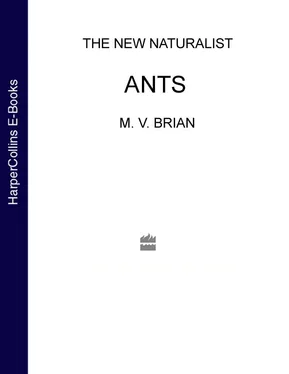Although formicine ants do not collect seeds systematically records of this do exist. Lasius alienus collects the seeds of the dwarf gorse, Ulex minor ; it only eats the oily caruncle, the rest is rejected undamaged and will germinate satisfactorily. The suggestion that the gorse is distributed in this way is reasonable. Lasius niger has been seen with viola and primula seeds; again, it only eats the stalk and the caruncle which contain oil and the rest presumably germinates after being thrown away by the ants. Wood ants, too, will take some kinds of seeds if these are put in their tracks; they, too, prefer the oily ones. The trapping results with Formica polyctena already mentioned show that a great many seeds are taken in along with other vegetable matter, such as buds and twigs; even pebbles coated with vegetable oil were picked up and carried away but soon rejected.
Ants lick up many juices that exude from plants, particularly from extra-floral nectaries. A good example is the zone near the base of the growing bracken frond which secretes an attractive solution on the frond pushing up through the soil in early spring. Both Lasius alienus and Lasius niger are very fond of this; they excavate a space around the base of the frond and from positions here they interfere with the passage of other species. A number of species collect from ling, the principal heathland shrub; unlike most plants this has a little protein in its nectar and it is just conceivable that this could help larval growth. Ants are frequently found in flowers that do not produce nectar. Lasius niger may be found in the flowers of the wild poppy which produces only pollen, almost certainly of no use to them. Of course they may be lying in wait for insects attracted by the pollen. Honeybees might be caught by Lasius niger if several ants acted together but there must be many smaller insects that could be overpowered easily. Pollination by ants is not thought to be frequent but it could happen; they might transfer pollen to the stigma in their wanderings and this might be important for some plants; little is known about this. Nor is much known about how plants protect their nectaries from ants; it is usually suggested that a long corolla tube, down which only a bee can get its tongue, is in itself quite adequate, but surely ants could easily bite through to the sugar, at least one species of bumble-bee does. Honeydew is not strictly a plant exudate, for in passing through the body of the bug (usually an aphid or a scale insect) it undergoes considerable change. Aphids receive the sap more or less passively as it is under some pressure from inside the plant; they control its flow by means of a valve in their head; others feed actively as well. Though the food-carrying channels of the plant (sieve tubes of the phloem) are the most usual place from which the bugs obtain nutriment, there are some which feed on other parts, such as the leaf tissues. Honeydew has had some food substances taken out and some excretory products added. It is now known to contain a mixture of sugars, organic acids, alcohols, plant hormones, salts, vitamins, amino acids and amides. It is difficult to quantify this as it varies with the age of the plant and the aphid position on the plant, as well as the current weather and season but 10% dry material is probably a fair average. Most of this is carbohydrate but about one-third may be nitrogenous. Not only are the ordinary plant sugars present (glucose, fructose and sucrose) but some additional ones appear to be synthesized by the aphid itself; such is melezitose. The nitrogenous compounds are mainly amino acids coming directly from the plant sap, of which at least twelve kinds are common. There are no proteins. This means that honeydew can provide many of the growth substances needed but in rather small quantities. Laboratory experiments have shown in fact that auxiliary protein sources are needed for normal growth. However, during winter, honeydew from root-feeding aphids may yield enough amino acids to maintain the protein reserves of adult ants in a very satisfactory state.
The relationship between these bugs and ants has evolved from one of casual contact in which the latter merely scavenge for bug excretions lying on leaves, as do honeybees, wasps and very many other insects, to one involving a very high degree of mutual dependence. The relationship between the common Lasius niger and the Black Bean aphis, Aphis fabae, on the broad bean, has been carefully studied recently. The ant keeps the bean free of sticky honeydew in which moulds are likely to grow and prevents the aphis cast skins from adhering. This is because instead of ejecting their excretions freely, as they do if unattended, these aphids wait until an ant touches them and then release a droplet of honeydew. They quite clearly save this up, for if the ant refuses to collect, it can be and often is withdrawn. Aphids also wave their hind legs in the air less when ants are about. All these and other behavioural changes persist for some time after all the ants have been taken away. They vanish only gradually.
Other aphis species that are more often associated with ants have lost their ability to excrete independently. Instead of a large tail-piece (cauda) that helps in the ejection of fluids they have a small one and a ring of hairs round the anus that holds excrement until the ants can suck it up. Also, instead of a pair of cornicles at the rear of the abdomen that secrete quick-setting, deterrent waxes, they are without such weapons. Underground aphids do not usually shoot their excrement away; it is collected on wax plates and put in the soil crevices, but those which are regularly associated with ants simply have the circle of hairs round the anus.
Ant-attended bean aphids produce about twice as much honeydew as unattended ones and Aphis sambuci with wood ants give three times as much honeydew as normal. No doubt this arises partly from the extra contacts that the ants provide, exciting the aphids and making them eat more and hence, of course, excrete more. Possibly, too, the instant removal of these liquids prevents accumulation starting an inhibitory back action. Other factors are certainly involved; thus, the part of the plant on which the Bean aphis feeds is actively influenced by Lasius niger. They remain for much longer on the younger, more productive tissues where presumably they obtain better food. The aphids are also kept on the underside of the plant and cluster more tightly into larger groups. Both a rich food supply and high density are known to increase the tendency for sexual forms to be produced in ant-free conditions and yet when ants are present this increase in reproductive rate is very much delayed. The complete answer to this question is not yet known; at the moment it is thought that indirect influences on the movement of aphids are more likely to be important than direct ones which act physiologically.
It has often been noticed that Lasius niger protect their aphids from some of their enemies; they remove the larvae and even the eggs of ladybirds and hoverflies; the adult ladybird, though too big for them to lift, can be driven away. Not all observers agree about this, and it is true that some ladybirds and hoverflies can avoid workers of Lasius niger ; so, too, can a number of insect parasitoids and indeed, one of these animals has evolved the ability to parasitize aphids underground and even take honeydew from them whilst ants are in attendance; the ants may even feed it. Such a special case in no way invalidates the generality that ants reduce interference with aphids by their enemies. The degree of ant vigilance and sensitivity probably decreases with the distance of the group of aphids from the ant nest and with the current state of their food supply. Much variation is also found between ant species in this respect, for Lasius flavus is undoubtedly able to exclude aphid enemies more effectively than Lasius niger , though this might simply be due to the fact that their nests are closed and their aphids live underground. The wood ant is also known to repel, if not attack, parasitic insects but is said by some ecologists to be less effective against hoverflies and ladybirds. Many aphids and coccids attended by ants have shelters of soil and vegetable particles built around them. These must help the ant to keep off dangerous animals as well as providing a more equable microclimate, not only for the benefit of the bugs but also for the ants which are reluctant to forage in wet and windy weather. Formica rufa cannot construct aerial chambers and loses a lot of aphids during storms but it does excavate underground and some of its aerial aphids may be found there.
Читать дальше












